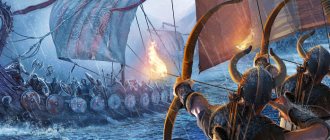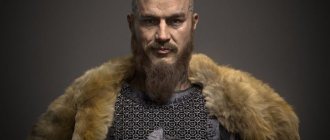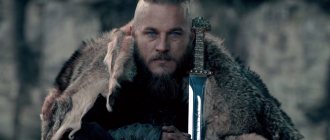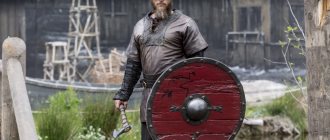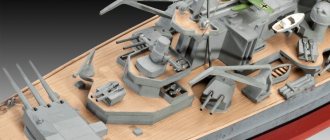Modern reenactors depict Vikings. On the sides of the ship there are shields protecting the rowers. They were not used in hand-to-hand combat. The last two centuries of the first millennium became an extremely turbulent time for the Christian states that were forming in Europe. The main reason for this was the countless raids of the Vikings - fierce and warlike pagans who came from the Scandinavian Peninsula, where the ancestors of modern Danes, Norwegians and Swedes then lived. The level of danger was so great that, starting in May 888, in many Catholic churches in Europe, during each prayer service, priests, turning to God, asked for “liberation from the rage of the Normans.” Describing the people known in the Middle Ages as Vikings, Wikipedia indicates that their name comes from the word vi'k ("bay"). But were they simply sea robbers, either coming from the “wicka”, that is, the bay, or hiding in it, or are we talking about a larger-scale phenomenon?
Reasons for the appearance of the Vikings
Answering the question of who the Vikings were, who they were and where they came from, it should be noted that we are not talking about representatives of some people alien to the inhabitants of the rest of Europe. These were the same heirs of the ancient Germanic tribes as the Franks or Burgundians. The Angles, Saxons and Jutes also had a common origin with the Vikings, who conquered almost all of the British Isles in the 5th-6th centuries. Probably, in any case, they could easily understand each other's spoken speech. By studying what language the Vikings spoke, scientists came to the conclusion that it was common to all tribes living in Scandinavia. This follows, in particular, from the fact that the examples of ancient runic writing used by the Vikings that have survived to this day are equally understandable to modern Danes, Norwegians and Swedes.
Samples of runic writing of various peoples
The difference between the inhabitants of the Scandinavian Peninsula and those who lived in the territory of modern France or England was determined by the following two factors:
- Religion. The Franks and Saxons managed to become Christians by the 9th century AD (that is, by the beginning of the “Viking Age”), while the ancestors of the Swedes, Norwegians and Danes retained the pagan religion with all its features;
- Level of development of feudalism. Europe was already experiencing the Middle Ages, while in early medieval Scandinavia many elements of the tribal system were still preserved.
Of course, this was not enough for the Vikings to appear. Historians even today argue about the reasons why people who until recently did not leave Scandinavia began to increasingly go on long journeys. One possible version is overpopulation and the associated economic crisis. Archeology, however, indicates that on the eve of the “Viking Age,” Scandinavian settlements did not become poorer, but grew richer.
It is possible that overpopulation actually took place, but not “general”, but “elite” - rich people had many sons, of whom (in accordance with ancient law) only one had the right to inherit, while others had to look for some for themselves. then other ways to “increase well-being.” One of these methods could be trade - but not any, but only the most profitable, and another - outright robbery.
Attempts to redistribute wealth initially led to constant civil strife, and then spilled out in the form of raids on neighboring lands. This happened almost immediately after the Scandinavians learned to sail ships.
The Vikings land on shore.
The round shields used in the first campaigns are depicted. An additional factor that made the appearance of the Vikings possible was the Arab expansion in Europe, which culminated in the capture of part of the Iberian Peninsula in the 8th century. As a result of this event, trade routes through the Mediterranean were lost and a shortage of silver arose, which may have been a kind of “last straw” that prompted the Scandinavian warriors to head to foreign shores.
Wounds prone to blood poisoning
If you scratched your finger, you lost the limb.
Still from the TV series “Vikings” As you can easily see, the Scandinavians’ medicine at that time was so-so. The lack of understanding that it would be a good idea to wash and disinfect wounds often resulted in death for them. Sometimes things got funny.
In The Orkney Saga, recorded by H. Pálsson, P. G. Edwards. Orkneyinga Saga: The History of the Earls of Orkney between 1192 and 1206 by an unknown Icelandic chronicler tells the story of Sigurd Øysteinsson, Earl of Orkney, nicknamed the Mighty. Earl, by the way, is a tribal leader, and from this word later came earl, that is, count.
In general, Sigurd was once challenged by the Scottish leader Mael Brigte - he really did not want to pay tribute to the Vikings. The parties promised each other to fight with small forces, 40 warriors on each side.
However, at the last moment Sigurd decided: “I am the master of my word, I wanted - I gave, I wanted - I took.” And he took 80 fighters with him.
It is easy to guess that the Scandinavians won. As a warning to other enemies, Sigurd hung the head of Mael Brigte on the saddle. And during the race he injured his bare thigh (apparently it was summer) on Mael’s teeth. The wound became infected, and the winner died of gangrene.
Sigurd's example teaches us two things. First, always treat even the most minor scratches. Secondly, when leaving the house, do not forget to put on pants.
Viking ships and their art of navigation
Despite the fact that sails, as is known from history, were widely used already in ancient times, Scandinavian ships for a long time moved exclusively with oars. One reason for this was that early boats, built in the second and third centuries AD, for example, did not have a keel. The absence of this important element makes the sailboat extremely unstable - the first strong gust of wind will simply capsize it.
The first ship with a “rudimentary” keel, according to historians, was the “Kvalsynn Ship”, created in Scandinavia around the year 700. In particular, on the island of Gotland, archaeologists were able to discover several images of a sailing boat carved on stones. These monuments were made at the beginning of the 8th century.
Further development of shipbuilding technologies led in the 9th century to the appearance of the famous longships - the main warships of the Vikings. These were sailing and rowing ships, sometimes reaching almost 20 meters in length. Their speed on the open sea when sailing sometimes reached 15 and even 20 knots. Each side had the same number of special ports - holes for oars.
A modern “replica” of a Viking transport ship
The number of rowers on the largest known longships was 32 people, 16 on each side. The ship's hull was symmetrical, which made it possible to move in any direction without turning around. The bow was distinguished from the stern by a wooden sculpture installed in the front part - an image of a dragon, thanks to which the ship got its name.
Despite the fact that the drakkar's sail was an ordinary rectangle, it was possible, by tucking its edges, to sail not only with the wind, but also almost against it, lying in a steep close-hauled position. At the same time, the ship tilted and could be filled with water through the oar ports, so over time, special “plugs” began to be made for them. At the same time, there was no pump on the ship, although devices of this kind already existed. Therefore, if water still overflowed the side, it was necessary to simply bail it out.
Snekkars, longships, and knarrs used for transporting goods turned out to be seaworthy enough for the Vikings to subsequently successfully reach not only the British Isles, but also Iceland, and then to the territory of the future Canada, thereby being several centuries ahead of the famous Columbus.
Housing.
Peasant dwellings were usually simple one-room houses, built either from tightly fitted vertical beams, or more often from wickerwork coated with clay. Wealthy people usually lived in a large rectangular house, which housed numerous relatives. In heavily forested Scandinavia, such houses were built from wood, often in combination with clay, and in Iceland and Greenland, where wood was scarce, local stone was widely used. There they built walls 90 cm thick or more. Roofs were usually covered with peat. The central living room of the house was low and dark, with a long fireplace in the middle of it. There they cooked, ate and slept. Sometimes inside the house, pillars were installed in a row along the walls to support the roof, and the side rooms fenced off in this way were used as bedrooms.
The first Viking campaigns
Historians generally consider the beginning of the Viking Age to be 793, when Lindisfarne Monastery, located on a small tidal island off the north-eastern shore of the largest of the British Isles, was attacked. Aliens from Scandinavia plundered the monastery and killed many priests, shocking the few surviving monks with their cruelty.
Fortress on the island of Lindisfarne, site of one of the first Viking landings
Subsequently, churches, cathedrals and monasteries became one of the main targets of predatory raids by Scandinavian sailors. This is explained quite simply - all these places were a concentration of a wide variety of valuable items, from silver and gold to various fabrics. Of course, the Scandinavians, who then remained “ungodly pagans,” did not feel any reverence for the churches.
It subsequently turned out that four years before the attack on Lindisfarne, the Vikings landed in South-West England, near Dorset. In this case, they killed the local feudal lord along with his small retinue. Most likely, this attack was not the first. Due to the fact that the Vikings sought to destroy everyone they could meet, there were often simply no witnesses left and the event was not chronicled.
In subsequent years, several more monasteries were plundered in what is now England. In addition, the Vikings visited Ireland, and a year before the end of the 8th century they first “visited” France, more precisely, the Empire of Charlemagne. In all these cases, the raids were carried out according to the “classical” pattern - landing on land, a swift and brutal attack, robbery and a hasty retreat with the loot on ships.
However, already in these early years there were definite signs that the Vikings were not just ordinary sea raiders. In particular, having landed on the Orkney and Shetland Islands, Scandinavian warriors created settlements there. For some time it was believed that all the local residents were killed, but archaeologists were able to prove that this was not the case.
Landing sites of Scandinavian troops at the early stage of the Viking Age
In 810, the islands located near the coast of Friesland came under attack from the Vikings. In its scale, this attack no longer resembled just a predatory raid, but a large and well-thought-out military operation. It is known that the Danish king Gottfried led the invaders, and the number of ships that he brought with him, as chroniclers say, reached two hundred. This, of course, could not have happened without repeated exaggeration.
One way or another, until 830 or even somewhat later, the attacks of the “northern barbarians” were of a relatively limited nature. In areas further offshore, these attacks were often not even known.
Unhealthy atmosphere in homes
Reconstructed longhouse of a Viking chieftain in the Lofoten Islands, Norway. Image: Jörg Hempel / Wikimedia Commons You've probably heard that the Vikings lived in longhouses. This is a typical Scandinavian home of that era - a large and elongated building with only one room. There is a fireplace, a bedroom, a dining room, and a workshop. Have you already imagined cozy gatherings by the light of the fire?
Men drink beer from curved horns and tell stories, and blond beauties spin and sing funny songs? Well, that's not all that awaits you.
You probably wouldn't like it in a longhouse, because not only did the Vikings live there with their families, but also their livestock Viking homes / The National Museum of Denmar. Not all Scandinavians were wealthy enough to afford such luxury as a barn.
Livestock, such as pigs, goats and cows, were simply placed in the far corner and separated by some kind of wooden partition so that they would not wander around the house. This was especially useful in winter, as the animals warmed the house with the warmth of their bodies.
In addition, it was safer to keep your breadwinners close by: there was less chance that a neighbor, whom you were rude to while drinking honey, would steal some goat from your barn simply out of spite.
But, of course, animals not only made the air in the room warmer, but also added many new and varied aromas to it.
A reconstructed replica of the Viking village of Hedeby, built in Germany. Image: Frank Vincentz/Wikimedia Commons
The situation was made worse by very poor ventilation Living Conditions and Indoor Air Quality in a Reconstructed Viking House / EXARC: the house had only a chimney hole in the ceiling and one door. There were no windows. Because of this, the Scandinavians suffered greatly from carbon monoxide generated by their hearths, as well as from a variety of respiratory infections and lung diseases.
The constant smoke in the room caused bronchitis, cerebrovascular diseases and cancer among the residents of the longhouse, especially women and children. Naturally, all this was attributed to the anger of Odin or the tricks of Loki.
Period of large-scale expansion
Starting around 830, Viking activity began to increase - at first relatively smoothly, and then like an avalanche. In 845, Hamburg and Paris were captured almost simultaneously. The Frankish king Charles the Bald had to pay the Vikings seven thousand pounds of silver to save his capital from complete destruction. Other cities were less fortunate - Rouen, Tours, Angers and Nantes were plundered and burned, and a significant part of their inhabitants died.
The cruel invaders, passing along the beds of the Loire, Garonne, Seine, Meuse, Ems, Weser and other rivers, devastated everything in their path. In particular, Bordeaux, Toulouse, Angouleme, Limoges suffered - the list goes on for a long time. In its scale, this disaster was comparable to that experienced by those countries that were invaded by the Mongols four hundred years later.
Viking expansion in Europe and beyond
Amazingly, the Vikings had enough resources to simultaneously organize a separate “expedition” to the Iberian Peninsula, along with the plunder of the territory of the former Empire of Charlemagne, with a visit to North Africa - and this is not to mention the ongoing attacks on the British Isles.
During these same years, the Vikings again showed themselves not only as robbers, but also as colonizers. In particular, in 841 it was they who became the founders of Dublin, the modern capital of Ireland. In addition, in the second half of the century, a “Danish law area” appeared on the map of what is now England, another direct result of the constant expansion of the Vikings. True, London was outside this area, but this city was captured and plundered several times.
In 885, the Vikings laid siege to Paris again. Their troops appeared in various places in northern and eastern France, as well as in the territory of such modern countries as Germany, Holland and Belgium. It seemed that there would be no end to the catastrophe, but already in 890 and 891 the invaders suffered two major defeats - first in England, and then on the continent. From that moment on, the number of raids and robberies began to decline - up to 90% of all warriors who went on campaigns died.
Of course, the world did not recover immediately; over time, Viking attacks resumed, but they no longer reached such a significant scale. Nevertheless, they still managed to conquer England again in the new millennium and capture London. This happened in 1013, that is, in the 11th century.
The end of the Viking Age is considered to be 1066, when King Harald the Severe, a native of Norway who aspired to become king of England, was killed in another battle.
Norwegian King Harald III the Severe.
His death is considered the end of the Viking Age. Just weeks after his death, Britain was conquered by William the Conqueror. And although he was a Duke from Normandy, he is not usually considered a Viking.
One of the many “side effects” of the Scandinavian expansion was the discovery and subsequent settlement of Iceland. At first, this land was apparently considered as a transit point on the long journey to the shores of North America, where the Vikings occupied a special territory called Vinland, but after the “Christianization” of Norway and Denmark, the cold islands turned into a refuge for those who did not want to change your religion. Of course, the “evacuation” ultimately only delayed the inevitable.
Unflattering nicknames
Scandinavian warrior.
A still from the TV series “Vikings” You’ve probably heard that the Scandinavians had different nicknames, for example Eric the Red or Ivar the Boneless. These creative pseudonyms were given to them by their comrades for better recognition. The Vikings did not have surnames - only patronymics, and they had to be distinguished somehow.
But the Vikings did not always get the flattering nicknames Viking Nicknames / Medievalists. Historian Paul Peterson from the University of Minnesota, having studied the sagas of those times, reports that in addition to all sorts of Bloody Axes and Mighty Hands, there were guys among the Vikings who were less fortunate. For example, Eystein the Dirty Bzdun, Aiden the Thin-Haired, Thorstein the Loser or Ulf the Cross-Eyed.
The nickname could even be given posthumously. One Viking, Njal Thorgeirsson, was nicknamed the Fireman because he and his family died in a fire when their enemies set fire to his house.
Nicknames were also given to women. It’s not hard to guess why Fat Tordis stood out. Although sometimes they were named based on the opposite: about a certain Little Thord in the sagas it was said that he was “the tallest of all people, and, in addition, he is strong and strong.”
In general, if the northerners decide to call you something, pray that the call sign is, for example, “Fierce” and not “Smelly” or something even worse.
Reasons for the success and subsequent decline of Viking activity
No matter how strong and ferocious the Scandinavian warriors were, they were far inferior in numbers to the troops that the European kings had by the 18th and 9th centuries. Therefore, the numerous victories of the Vikings in the eyes of modern people look like some kind of miracle. Nevertheless, it is relatively easy to explain the reasons for these successes.
The first raids were truly “pin pricks”. Their danger was not appreciated either in England or on the Continent. Therefore, almost no measures were taken to protect the coast. On the other hand, the attacks were extremely unpredictable - most often the jarl or rich bond, who led the Viking squad that set off on a voyage, did not even know where exactly he would rob and what would be his goal.
In those days, none of the European rulers had so many troops to cover the coast along its entire length for any length of time, which made it possible to strike at unprotected places.
An image of Rorik of Jutland, the Danish king, one of the first Vikings to enter the service of the Frankish kings. According to one version, it was he who was Rurik from Russian chronicles
The success of the large-scale Viking expansion in the middle and second half of the 9th century AD was greatly facilitated by the crisis and subsequent collapse of Charlemagne's empire. The defining moment here was the death of Louis I the Pious in 840. Immediately after it, a civil war broke out in the country, as a result of which, three years later, several kingdoms hostile to each other arose in place of a single state, which the “guests from Scandinavia” took advantage of.
It is also necessary to take into account “technical reasons” - the medieval feudal army required quite a lot of time to form, arm and go on a campaign. While the “organizational events” were taking place, the Vikings managed not only to plunder several cities, but also to return to their native lands with the loot.
It was possible to extinguish the aggressive and predatory activity of the Vikings with the help of political rather than military measures. The basis of this policy was territorial concessions. For example, the Vikings had Normandy at their disposal - they could live there and run their own household. This was not a simple “ransom” - in response, the kings and jarls actually went into the service of the French kings and after that acted as defenders of the coast from their former compatriots.
In some cases, the territories acquired by the Vikings became the basis for raids on Scandinavia itself. In particular, Denmark and Norway were attacked. Such raids were not considered a betrayal - after all, the Vikings never formed any common nation; only relatives were theirs, and even then not always.
Olaf (Olav) Trygvasson, one of the active participants in the baptism of Rus', is proclaimed King of Norway
The church played a decisive role in the weakening and disappearance of the Vikings. Its ministers first went to Sweden, but then expanded their activities to wider territories. Despite the fact that the Scandinavians resisted attempts at Christianization for quite a long time, in the end the missionaries managed to achieve their goal - the new religion no longer made it possible to treat robberies and murders as a feat for the glory of the gods.
Gathering of the people's militia
When it was necessary to protect the country from attack or, later, to assemble a large army for a campaign of conquest, they sent out a “military arrow” - a call for the collection of the people’s militia, leidung (leidang, ledung). In fact, this is military service; additional meaning is a fleet of ships.
However, leidung did not always mean complete military dependence. Sometimes local jarls, bonds, and leaders temporarily assembled their militia squads, carrying out raids, conquering lands, and sometimes competing with kings.
Three estates (manngörð) were required to provide 1 person. In rare cases, the king could summon 2 people from 3 households.
In Norway, each coastal region, in Denmark skipen, had to provide 1 ship (25-70 people). In Sweden, each region was divided into hundreds. Hundred was supposed to provide four ships, 100 people.
From the leaders (headings) of districts, regions (herads), the heads of militias - hersirs - were chosen.
The king could demand the provision of people to his personal hird. For example, the requirements of Harald Fairhair:
Each jarl had four hersir or more under his command, and each hersir was to receive twenty marks (weizls) for his maintenance. Each jarl had to supply the king with sixty warriors, and each hersir - twenty.
Snorri Sturluson, 12th century.
When the Hird grew up, people who were not close to the leader were called Lid (lið, an analogy with our “people”). Otherwise, the leader was the name given to the entire assembled army, a large army.
Additionally:
- Manngords were united into a ship district - skipreidi, skipsysla in Norway, hamna in Sweden or havn in Denmark;
- Helmsman (stýrimaðr) - led the ship's squad;
- Lendrmans (lendrmaðr), vassals of the king, usually from honored retired soldiers who looked after the lands of the leaders, commanded flotillas of ships.
Main features of Viking military art
The Vikings would never have achieved any victories on the battlefield if they were simply bands of armed robbers. Perhaps the chroniclers are not entirely right when they call the numerous northern warriors who terrorized Europe for almost two hundred years a “great army,” but we still have to admit that it was a fairly organized force, even if it never had a single command.
Formation of the squad
Most of the Vikings were so-called “bonds”. This is how in Scandinavia they designated free landowners, as well as, importantly, their children, who may not have received their own allotment. All of them had the right to bear arms and participate in tings - special meetings, the closest analogue of which can be considered, in particular, the well-known Novgorod veche.
The very first raids on England were apparently carried out exclusively by bondsmen who had turned into seafarers; jarls and, especially, kings joined this “movement” later. When this happened, on some ships, along with voluntary participants in the campaigns, mercenaries began to appear, receiving salaries for their help.
Attacking Vikings
Berserkers were hired separately - rather strange people who, even from the point of view of an ordinary Viking, accustomed to all kinds of cruelty, were extremely dangerous and half-insane outcasts. They fought not for money and booty, but only in order to get to Valhalla as soon as possible and meet Odin there.
Battle tactics
In most cases, the Vikings fought on foot, similar to the ancient Greek phalanx. This formation was called a “shield wall.” The berserkers, who served as an assault force, fought most often outside the ranks. They attacked first and apparently were often successful. However, the systematic advance of the “shield wall” made it possible to sweep away any enemy.
The Vikings' worst enemy was heavy cavalry. Sometimes she managed to break through the formation, and then it became very difficult to avoid defeat. The Vikings themselves rarely fought on horseback. Such episodes occurred most often already in the 10th century, both in England and France. Horses were captured from the enemy, since there were no ways to transport them on longships - at best, only one or two horses could be transported.
The Vikings fought at sea by boarding - the ships were connected and a single battlefield emerged. Maneuvering was carried out with the help of oars - the sails were lowered so that random gusts of wind would not interfere. At the same time, the ships, moving towards rapprochement, lined up in lines and carried out intensive shelling of the enemy from bows. At short distances, throwing spears and stones were used, the stock of which was specially created before the battle.
Modern reproduction of the "shield wall"
To protect the rowers from all this, round shields were installed along the sides of the drakkar. It was impossible to use them in hand-to-hand combat due to their large weight and size, but they performed their main function well.
Main types of weapons
The Viking armament as a whole differed little from the “pan-European” one. True, today it is already difficult to judge its quality. The usual “set” consisted of the following elements:
- Spears. Most likely, this was the main weapon. Viking spears that have survived to this day have a fairly long tip with well-developed side blades. This means that they could be used for slashing attacks;
- Swords. The most versatile type of weapon. The average blade length is from 90 cm to a meter. There is also information about the use of swords with one-sided sharpening (i.e., actually broadswords);
- Axes. It is this type of weapon that is usually found in the hands of Vikings in modern images. There are reasons for this - archaeologists discovered the most axes. Compared to swords, axes are cheap and also allow you to deliver a more concentrated blow.
Bows and shortened spears were used as throwing weapons. There is little information about them, despite the fact that in the retinue of some kings there were real “snipers” who confidently hit targets at great distances.
Protective equipment could be leather armor of various types, and somewhat less commonly, chain mail, which became longer and longer over the years. In addition, every Viking certainly had a wooden shield. At first its shape was round, but towards the beginning of the second millennium the shields became almond-shaped.
Typical Viking battle ax - Brodex
Vikings outside the battlefield
Many of the actions of the Vikings today seem like wild and crazy antics. Nevertheless, it would hardly be correct to describe these people in an exclusively negative way, as their contemporaries did.
Viking religion and moral principles
As you know, the Vikings were pagans. Their peculiar religion coincided in its main features with the “all-German” one. In particular, at the head of the pantheon of gods was Odin (some Germanic tribes called him Wotan). It should be noted that many details concerning both individual characters and entire concepts appearing in Scandinavian myths could have been “thought out” several centuries after the end of the Viking Age; therefore, they should be treated with a certain caution.
Odin, in accordance with the ideas of the Vikings, belongs to Valhalla - a banquet hall in the “upper world”, Asgard. Only warriors who died on the battlefield can get there. The inhabitants of Valhalla feast daily - they eat boar meat and drink intoxicating mead, and then take up swords and fight to the death - so that they can then be resurrected again and continue the feast. Such ideas about heavenly life to some extent reflect the everyday ancient Germanic reality, when everyone waged an endless war with each other generation after generation.
The “selection” for Valhalla is carried out by Valkyries - warrior maidens, soaring in the sky on winged horses and controlling the course of battles. They are the ones who decide who lives and who dies. The feast in Valhalla does not last forever - in the future, Ragnarok, the end of the world, will inevitably come, during which all the gods, including Odin, will die. He will be destroyed by the monstrous wolf Fenrir, who is sometimes considered identical to Garmr, the four-eyed guardian of the kingdom of the dead.
Ragnarok, death of the gods. In the center of the picture is Odin, galloping towards Fenrir, in the background is Thor, grappling in a mortal duel with the world serpent Ermungandr
The most unusual thing in this pan-German religious mythology was that at the head of the pantheon of gods is not the thunderer Thor, whose analogues are, of course, the Greek Zeus and the Slavic Perun, but Odin. The Romans believed that this character in their own religion corresponded to Mercury (that is, the Greek Hermes). Indirect confirmation of this version can be considered the significant successes that the Vikings managed to achieve in trade.
The “relegation” of Thor to the background entailed a number of consequences, one of which was the complete absence of any caste of priests or clergy among the Vikings. In fact, each bond performed the divine service himself and did not need any intermediaries.
It is in religion that one should apparently look for the origins of not only the courage, but also the inhuman cruelty of the Vikings. For example, when they impaled captured small children on spears, this was seen as a sacrifice to Odin. The spear itself was perceived as a kind of model of the “world tree” connecting different worlds.
The Vikings also did not value their own lives very much, believing, in particular, that going to certain death in battle was an enviable fate, since here ending up in Valhalla became simply inevitable. Of course, such beliefs were not typical for everyone, but not only for half-mad berserkers.
Quite often the Vikings attacked each other. The reason for this was usually the desire to get rich. Thus, ships that came with booty from England or France were sometimes plundered upon returning to their own harbor.
Winged warrior maiden Valkyrie
Another motive for the attack could have been blood feud. This old custom was very common in Scandinavia. A classic case of such reprisals is described in the legends about the Danish prince Amled, the prototype of Shakespeare's Hamlet - oddly enough, this man was also a real Viking.
Social structure
Along with bonds, kings and jarls, a considerable number of slaves lived in Scandinavia. Their position was, of course, unenviable. Only in some cases did they manage to occupy a more or less privileged position. Slaves were bought and sold like ordinary things, and the fate of the girls sometimes became simply terrible. There were no ways to get out of slavery, and the children of slaves were also considered private property.
At the same time, it should be noted that free women in Scandinavia had the same rights as men. They often occupied leadership positions, and if they wished, they could go on a campaign of conquest. Nothing like this was observed in the Christian states of Europe in those years.
Any of the bonds could theoretically be elected at the Thing as a jarl or even a king, rising to a higher level in the general hierarchy. This, however, required that the previous leader be seriously guilty of something. This primitive form of democracy persisted for a long time even after the completion of the “Christianization” of Scandinavia.
Viking treasure found in the Smolensk region. Such burials were usually left near trade routes
The names of the Vikings had a very specific semantic content. Many of them are directly related to weapons and battles. Such, for example, are the names Egil (in Danish - blade), Einar - a warrior who fights alone, Bjorn - a bear - a symbol of rage in battle. According to the all-German tradition, names were supplemented with nicknames. But if among the Franks they were given mainly to kings (for example, Charles the Bald or Pepin the Short), then among the Scandinavians such a “second name” was assigned to almost every bond.
Another interesting feature of the Vikings is their entrepreneurial spirit. They understood well the importance of trade. Apparently, this is precisely what explains the fact that the “Varangians” were able to establish quite normal interaction with the Slavic tribes. In the territory where Ancient Rus' later arose, the Vikings behaved surprisingly peacefully, avoiding any conflicts for a long time. On the other hand, the Scandinavians sometimes used their trading expeditions to conduct “long-range reconnaissance,” collecting information about unprotected areas on the coast and selecting targets for subsequent attacks.
LIFESTYLE
Abroad, the Vikings acted as robbers, conquerors and traders, but at home they mainly farmed the land, hunted, fished and raised livestock. The independent peasant, working alone or with his relatives, formed the basis of Scandinavian society. No matter how small his allotment, he remained free and was not tied as a serf to land that belonged to another person. Family ties were strongly developed in all layers of Scandinavian society, and in important matters its members usually acted together with relatives. The clans jealously guarded the good names of their fellow tribesmen, and violating the honor of any of them often led to cruel civil strife.
Women played an important role in the family. They could own property and independently decide on marriage and divorce from an unsuitable spouse. However, outside the family hearth, women's participation in public life remained insignificant.
